
|   |

|   |
 e-mail: leelakaverivenkat@gmail.com Nirikshana: Natya Kala Conference marks its 39th year of celebration-1 Photos courtesy: NKC 2019 January 13, 2020 The 'pay for the Arts' drive of the convenor Rama Vaidyanathan and Aalaap, the creative collaborator, would seem to have fetched handsome results, for rarely has Krishna Gana Sabha's annual Natya Kala Conference (Dec 26-30, 2019) attracted the kind of 'sold out' auditorium experienced this year, with literally every seat occupied, notwithstanding an entry ticket for being part of each day's proceedings. O.S. Arun's dramatic entry from the auditorium to the stage singing the Ranga Stuti of the Abhinaya Darpana, heralded the start, with the welcome address by Shashwati Prabhu nostalgically recalling how the start of the Conference as an educative and interactive experience had begun in 1974 with Padma Subrahmanyam being conferred the Nritya Choodamani. This year's conference with Dr. Sonal Mansingh, Member of Parliament, Rajya Sabha as Chief guest, the award of 'Natya Kala Visharada ha' was conferred on Ranganayaki Jayaraman for her selfless teaching of Bharatanatyam, particularly among the under privileged sections of society. Speaking of the enormous spread of Bharatanatyam, Rama Vaidyanathan, in a well-structured address, pointed to the phenomenal growth of Bharatanatyam, bringing with the spread, its own problems of preserving tradition while embracing progress. The idea of inclusivity where tradition is celebrated while creativity is accepted, is not without its challenges. The naming of the conference as 'Nirikshana'(with the signature tune for the theme composed by Sudha Raghuraman) underlined the need to have a very close look at the 'chaotic bliss of order and disorder' which reigns today, and to probe and examine transitions of Bharatanatyam of the present. With shrinking space for dance writing, amidst euphoria on the one hand, and negativity on the other, the challenges clearly are many. Remembering her first appearance in Odissi in 1969 in the Krishna Gana Sabha space, and her miraculous return in 1975 after a near fatal accident, going on to receiving the Nritya Choodamani in 1992-'93, Sonal Mansingh in her inaugural address went for the central point of the entire Natya Kala exercise this year-dilating on the term 'Nirikshana' which means to gaze steadfastly, to observe, to perceive, to contemplate. The entire process had to begin with the exercise of knowing for oneself. The close outer look could involve the external or visual factors of an art presentation, while the more evolved process of 'Antara Nirikshana' could be an inward process based on the finer aspects of art and artiste. Thereafter, there was always the test the dancer had to pass with the 'rasika'. The speaker mentioned Sthoola, examining closely the broad aspects, or Sookshma entailing a deeper thought process looking into the subtle or finer aspects of what is presented. Quoting from Sastras, Sonal Mansingh maintained that merely seeing a performance is not closely looking. The rasika has to imbibe what the dancer presents. And it is this two-way process of artiste and rasika which is central to all in-depth analysing of an art form. Nirikshana automatically involves the 'Rasika sabha'. The main question then came, "In how many places today does a classical dancer find such a discerning audience?" Down memory lane 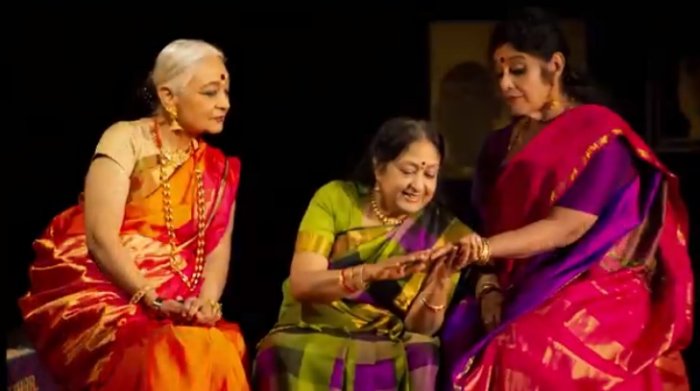 Viralimalai Kuravanji: Sudharani Raghupathy, Padma Subrahmanyam, Chitra Visweswaran The conference sessions began with the recapture of a page from the 1960s. It all started when Doordarshan's Mr. Goswami approached Madras Doordarshan producer Seeta Ratnakar, to try and see if she could get dancers together for a Pongal celebration. And late Shyamala Balakrishnan chimed in saying she had a script with the pre-Tyagaraja day music of Viralimalai Kuravanji (among the 65 Kuravanjis she had collected) learnt from a devadasi Mayamma. Divas Dr Padma Subrahmanyam, Prof Sudharani Raghupathy and Chitra Visweswaran were featured in an abridged version of Viralimalai Kuravanji, at a point of time when a straight forward colour recording was all that could be done with no editing facilities available. The viewers however were thrilled to experience the magical synergy of three dancers through the Doordarshan programme. To watch the very young graceful and zestful Padma, Sudharani and Chitra was a treat. The screening of some clips was followed by some live impromptu miming by the three dancers. The mind-numbing schedule of the conference with an 8am curtain raiser on four days pertaining to various Banis, concluding at about 3pm - the Soorya grahanam coming to the rescue on the first day with the opening at 1.30pm, made the event an endurance test for the older people- though enough of the enthusiastic young with their whistles and cheers was present right through to fill the auditorium. All told it was a carnival like atmosphere, with little shops with knick knacks and sarees set up between the mini and main auditorium. The early morning performances highlighting different Banis, with the mini Kamakoti hall bursting at the seams with a largely dance practicing audience, began with Dr.Vyjayantimala Bali's heritage featuring her student Dr. Sridhar Vasudevan. Stating that 'Sastra' for him was what the Guru gave to him, (he studied under her for all of 11 years) he said that his teacher was responsible for pushing him into learning Tamil. "No digital memories and notes. There was no English ever spoken in the class. She would talk about subtleties of other dance styles too." Vasudevan's foundation in music was a great help. When he was in the 10th class, he even sang for a Vyjayantimala concert in Delhi when the assigned vocalist could not make it. With her equal proficiency in singing and dancing, with bhakti the hallmark of her performances, Vyjayantimala never tired of explaining to him the finer aspects of a composition. Vasudevan maintains that most of his learning came through watching. After each recital, she would ask him about what she had done, to see how much he had absorbed. "She taught me no theory but the process of how she visualised the sahitya was an education for me. Often the teaching time would be after 11pm after which she would retire to bed, while I would mull over what was taught, rushing home early next morning to go to school. It was typical 'Gurukula Vasam'. After Melaprapti and Todi chollukettu in Roopakam, Vasudevan's rendition of the Todaiyamangalam "Jaya Janaki", in the 'Nakhamriga shareera' line describing Narasimha, was particularly evocative. "I try to do it exactly as I have seen my guru do it." From Kulashekhara Alwar's Tiruppavai, the prabandham to "pavazhavai Venkadam" provided the concluding moments of what was a very involved presentation with a fine singer in Sudha Raghuraman, and Himamshu Srivastava providing nattuvangam, Manohar Balatchandirane on mridangam and Raghavendra prasad on violin. 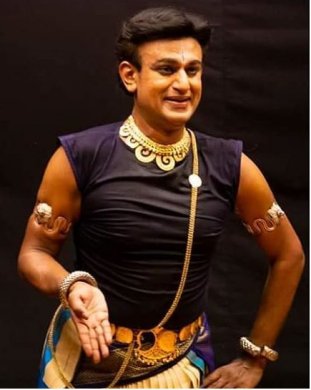 S Vasudevan 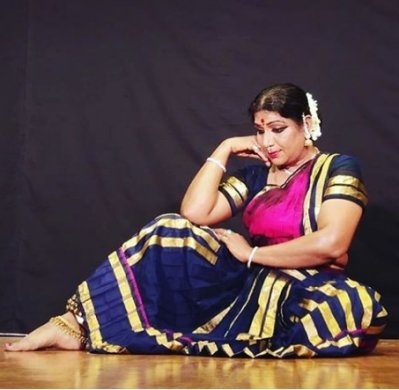 Narthaki Nataraj It was sringar again in the Kambhoji "Ivan yaro ariyen sakhiye" where the Nayika wonders, confiding in the sakhi, about the identity of the Lord, adorned with the Kaustubham, with one woman at his feet, another held close to his breast. "Is this my heart's chosen One after all, who has come in answer to my prayers?" The concluding Javali in Paras, a composition of Chinnaiyya of the Tanjavur Quartet, "Cheli balavantham balavantham ela ra" set to misra chapu talam was addressed to Mysore Maharaja Chamarajendra Wodeyar. The lyric portrays the married Nayika nervously admonishing her lover for appearing at the wrong time at her door - when her husband was sleeping inside and all elders were present. "Are you determined to get me into trouble?" Wry humour and irony lay in the dancer running her fingers over her mangal sutra - reaffirming her married credentials! 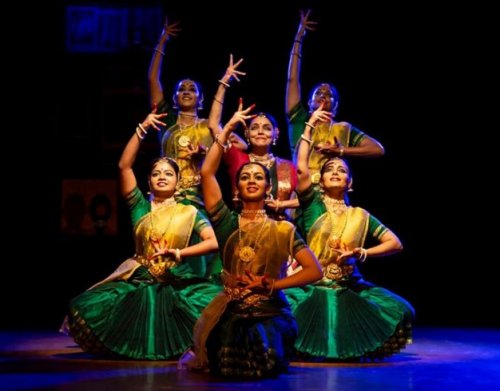 Sucheta Chapekar and group (photo: Vinay Dutta) A measure of the versatility of these Gurus was brought home seeing the same Kittappa Pillai lineage taking on such a different flavour in the programme of Sucheta Chapekar, who with her group presented solo and ensemble work based on the Tanjavur Nrutya Prabandha. Working with Kittappa Pillai on Marathi compositions of Shahaji and Sarofoji was an experience in 'national integration' for the dancer, Kittappa Pillai's deep understanding of and feel for music, ably succeeding in bringing the Marathi sahitya (duly explained by Sucheta to the Guru) alive. The presentation began with the group presenting Alarippu in Pancha Nadai, Sucheta's own choreography inspired by Kittappa Pillai's observations on Panchanadai in 28 counts (an addition of all nadais - 3,4,5,7 and 9 ), different from the way her earlier Guru Parvati Kumar had visualised this with tisram, chatusram, khandam, misram and sankeernam in separate units. This was followed by the Salaamu Daru "Lambodhara Herambha" set to ragas Suratti, Kalyani, Asaveri and Revagupti by Kittappa Pillai invoking Ganesha, Saraswati, Govinda and Mahishasuramardini, the Kula daivata of the Bhonsles. The group visualisation was by Arundhati Patwardhan, Sucheta's daughter / disciple. The abhinaya Daru "Sakhi piyu mero kahan ..." showing the virahotkanthita and khandita, for me, was the highlight of the presentation, the ragas like Behag, Kapi, Kanada and Hindolam setting off the sahitya beautifully - showing the Guru's appreciation of how the language of the sahitya had a gait which the music of the area also emulated and he chose all Hindustani ragas (used in Carnatic too) for the Marathi sahitya. The rendition by Sucheta full of subtlety and refinement was followed by "Pahile Krishna" in Anandabhairavi set to Deshadi, also presented with involved joy by Arundhati. The concluding item saw the group presenting Tillana in Bilahari, a Sarfoji composition choreographed by Sucheta. The Jatis were typical Kittappa Pillai. The entire exercise revealed the cultural inclusivity and the give and take existing among different gurus and community groups in Tanjavur kingdom. 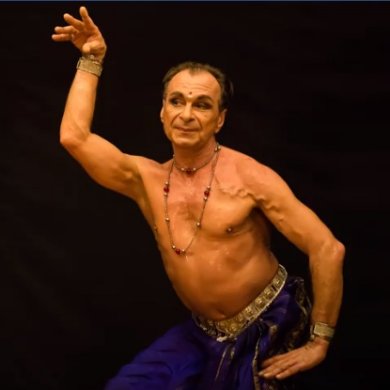 Dominique Delorme That 'The peerless contribution of Dr. Padma Subrahmanyam' should be represented by Dominique Delorme of France speaks for itself. Living so far in France and being able to retain the Indian fragrance in his art, is in itself an achievement. Starting his Bharatanatyam career with a French dancer named Malavika, he came under Guru Muthuswamy Pillai to become one of his finest disciples. His coming under Padma Subrahmanyam when she was producing her Doordarshan episodes on the Natya Sastra, changed his life and approach to dance and today there are few who can equal his perfection in demonstrating the Natya Sastra Karanas. With Gayatri Kannan as vocalist, Radhika for nattuvangam, Nagai P. Subramaniam on mridangam and Patanjali on flute, Dominique began the suite of Pada Subrahmanyam compositions with an evocative prayer to Ganesh, Hanuman, and Krishna based on Balamurali's composition in Arabhi. Invoking Siddhi Vinayaka, Vayuputra Hanuman with his curling tail and Yashoda's darling Krishna, the prayer ended with a short 'Jhekino' nritta segment added by Padma. The Ekadasa Ragamalika with 30 Karanas being presented was sheer perfection. After this, came the depiction of how Karanas combine to form Angaharas. Rasakaranrittam established the body /mind connect which formed the basis of Bharata's theory of the body and the nine rasas in relation to Rama's response to various situations was depicted with all energy and enthusiasm. In conclusion was the Tillana with a prayer for welfare of the entire universe and planet, set to Mahati ragam. The phenomenal exactitude of movement in Dominique's presentation, the dancer's body as supple today as thirty five years ago, in his other solo appearance devoted to 'Karanas in Contemporary Expression' underlined not just the dancer's versatility, but more so the universality of the Natya Sastra on which he based his three items. The first in Ashvakranta style used the Kunchita pada abandoned in most Indian styles. He brought into play Karanas like Udghatitam and Samanakam in what was a slow, very reposeful style. The next item done to music played on Rudiger Opermann's Harp with percussion provided by Jhatinder Thakur who lived in France and is now based in Kulu, comprised a garland of 22 Karanas. The last item "507 steps towards Liberation" influenced by the Sufi tradition of the Dervish was based on Shamanic drums and cymbals with a singer from Mongolia singing in voices resembling both male and female. The accordion was played by Servais Haanen. In this item he used Garudanritta hasta and Leenam Karana. In a brief exchange, Dominique said that he was eternally grateful to Padma Subrahmanyam for opening his eyes to the enormous potential of the Natya Sastra - for "any dance in any part of the world can be traced to movements mentioned in the Natya Sastra. By a thorough study of this treatise, I have become a world dancer. I feel so enriched."  Indira Kadambi 'Bequest of Kalanidhi Narayanan,' the last of the Bani sessions saw Indira Kadambi taking the stage in the mini auditorium teamed with her husband T.V. Ramprasadh, the Carnatic vocalist in what was titled "Vipralabdha Weaves." Comprising choice Padams, Javali and Ashtapadi presented in the tradition of her Guru, Indira provided some rare abhinaya moments. More than anything the recital proved how significant the music/dance togetherness is in the treatment of abhinaya. In the Tirupati Narayanaswamy Javali, "Vagalani bododhanalagu valachiti vo Saami" set to Behag raga, the wife reprimands Muruga for stooping to the level of becoming involved with what she believes is a woman of loose character. She wants assurance from him that he will never be swayed thus again. Indira's ability to lose herself totally in the moment of the dance is exceptional and with a singer who understands her every move, the blended dance/music impact is strong. "Indendu vaccitivira" in Surati with the Nayika sarcastically asking the wayward lover as to how he could lose his way coming to the wrong house, for this was not where the fish-eyed one with whom he had been dallying lived, is an oft rendered lyric - and yet the power and conviction brought to bear on the interpretation was out of the ordinary. The underlined message of stinging sarcasm was potent. Kavikunjara Bharati's Tamil Padam in Bhairavi, finds the resigned Nayika sadly admitting that just as spilt milk cannot be put back into the bottle, the tie of constancy in love once broken, cannot be cemented. "Inimel avarukkum enakkum oru podum inangaadadi." That one final flick and gesture of the hand while exiting, was telling, forcefully conveying that what is finished cannot be resurrected. Indira's abhinaya communication is uncluttered, each gesture and movement held in stillness, assuring clarity. The dancer brought out yet another manifestation of the vipralabdha in the Kshetrayya Padam "Vadaraka popove vaadela vaccini vaddu raavaddanavee, adioka yugamu" in Kambhoji. When the Nayika hears that her long lost lover is going to return, much after years of agonising fruitless wait for him, she says "That was another age. Tell him not to come." The line sung niraval fashion with Indira's expanded expressional language provided moments to treasure. The ashtapadi "Yahi Madhava" has jilted Radha comparing Krishna's lack of fidelity with the forked tongue of the snake even as the singer croons "Rajani janita guru jagara raga kasha atim alasanivesham." In the line "Charanakamala" reference when Radha's anguish knows no bounds seeing that the red lac from the other's lotus feet have left imprints on Krishna's sublime chest, the singing in Sindhu Bhairavi with Indira's innumerable sancharis, with both singer and dancer immersed, created a mesmerised hush in the audience. Altogether an abhinaya treat with Meera Sreenarayanan for nattuvangam, Lingaraju on the mridangam and Ishwar Ramakrishnan on violin. Abhinaya in this Conference found more than enough representation. The session 'Abhinaya Expeditions' had Srinidhi Chidambaram interpret a poem by Vairamuthu pertaining to the modern working woman who tries to divide her frenetic day between the baby requiring a lot of mothering and office work which will not brook delay. Trying an abhinaya meld suggesting tones and rhythms of these two very different occupations and spheres of activity, with the acquired Bharatanatyam vocabulary one is familiar with, must have been interesting and Sudha Raghuraman's music in Kamas, Nagavalli Kalyani and Sindubhairavi provided an interesting take-off point for Srinidhi's interesting portrayal. 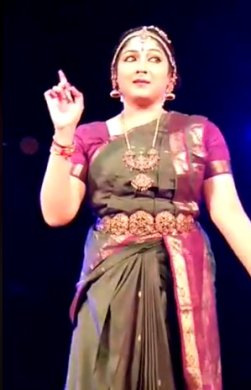 Srinidhi Chidambaram  Vidhya Subramanian (photo: Vinay Tiwari) Vidhya Subramanian's "Tum Radhe bano Shyam" was a quick process from the purely external facets, to the deeper inner mysteries of a human being, starting with an exchange of clothes and accoutrements between Radha and Krishna - the purely exterior exchange, leading to something more vital - the Being and the Becoming merging finally into a blend of male and female energies. As Krishna now, Radha attracts smitten devotees. Vidhya quoted one pregnant line "He maketh Himself as we, so that we may be like Him." With the 'Leela Hawa" set to Maru Behag by Sudha Raghuraman in her music, Vidhya's abhinaya enactment, sans inner restlessness, conveyed a sense of imbibing, when Radha becomes Krishna and Krishna becomes Radha. It was refreshing to see a male do a female role, the locale being Gokula where Sathyanarayana Raju as Radha is agonised by Krishna's departure to Mathura, without the flute that still has the lingering aroma of his breath and lips. Krishna without his flute, his identity! As she moans his leaving, in utter despair she realises "E kolalu bedavaiite," a pregnant sentence asserting that Krishna has shown that henceforth he will not need the flute - for this is a final goodbye to a life he lived, to enter the domain where he takes on a very different role. Set to a moving Desh and Shuddha Sarang, Sathyanarayana's depiction was very poignant, the final gesture of holding a real flute in the hands, very moving.  Sathyanarayana Raju 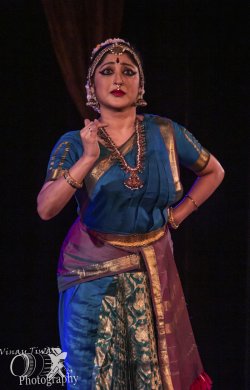 Lakshmi Gopalaswamy (photos: Vinay Tiwari)
Lakshmi Gopalaswamy chose an excerpt from Matrabhoota Kavi's
'Parijaapaharanam' wherein the nayika seeing signs of softening in
Nature, deduces that Krishna has arrived. Meditating on
those lotus feet banishes negativity. And Krishna as the lover becomes
in time pure consciousness of brahman. The item was a search for that
pure space within each one of us which is beyond thought and emotion.
The music set to Karaharapriya, Hameer Kalyani and Surati, evocatively
sung by Sudha Raghuraman, was expressed through Lakshmi's mobile
mukhabhinaya and internalised abhinaya. The other session on the last morning 'Of Metaphors and Manifestations' by Shobana Bhalchandra, pertaining once again to sahitya and abhinaya, was an informative session. With a very slender musical team comprising fine singer Kripalakshmi and T.K. Padmanabhan on the violin, Shobana's lec- dem brought out with clarity how metaphors and similes, restrictive when bound to a lyric, make rich material for interpretation in dance when unbound. Demonstrating the phrase from 'Yaro ivar yaro', 'Chandrabimba mukha' she described how qualities of the moon being fair, round faced, cool, luminous when reflected in the water, lotus etc would apply - but every comparison had to be relevant to the total context. She also showed how in "Dari joochuchunnadi", the phrase "Varija mukhi" (nayika) is very important for the sakhi conveying to the Lord the nayika's plight in endless waiting for his arrival. In a scene in Kumarasambhavam, she demonstrated how through Shiva's ornaments, Parvati can be described. From a varnam she demonstrated how a sentence like "saamaanya dorai alladi" where describing that the object of her love is no ordinary entity, the nayika can use comparisons. Comparisons, said Shobana, are more often than not linked with nature. She cautioned that amidst wealth of imagery available, it was important to study in detail to see what applied correctly in each case. How does one translate into dance, phrases like Rama Adirama, Ramabhirama, Ramaneeya Rama. The session clearly brought out the importance of studying the sahitya closely and understanding the nuances of language. It is familiarising oneself with poetry that enhances a dancer's ability to create similes and metaphors to suit the text. 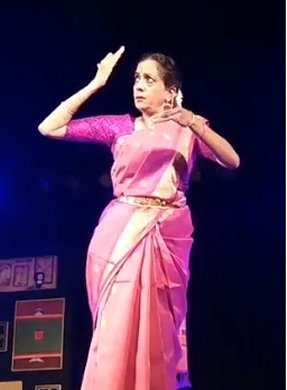 Shobana Bhalchandra 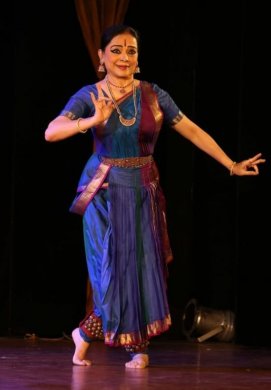 Malavika Sarukkai Speaking on the 'Expanding Canvas,' dancer Malavika Sarukkai dilated on her known conviction about Bharatanatyam, as a traditional classical style, sacred and secular, living in the eternal present. Imagination, intuition and strong technique for her, are essential qualities in a dancer. Impeccable technique alone gave one the language for the dance, though that was not sufficient. She gave an example of how in portraying the lament of the deer, her mother had insisted that just holding the mudra did not evoke the feel of the deer- which only came through deeply internalised abstraction of that essence (deerness) - acquiring an urgency giving the dance a sense of immediacy in communication. She compared it to the 'gamaka' in music, that extra something which is the hallmark embellishing all art. It was a good feeling to see dancer Alarmel Valli back in circulation after an absence. 'The Realms of Gold: My journey through dance' found her talking about how her gurus like Chokkalingam Pillai and Subbaraya pillai had generously given her the entirety of knowledge leading her through a whole lush forest in which one, after years of practice found what one wanted for each occasion. With her mother opening her mind to the beauty of poetry and literacy, and Mukthamma showing her how music was such an essential part of Bharatanatyam, she acquired, over the years, the ability of making stylised language into dynamic language of poetic expression, or "turning then and there into the here and now" (quoting from Arundati Subramaniam's poetry). Like blowing out the feather whistle which slowly opens out, her guru, while teaching her, through the musical Pandanallur sollukettu syllables made her understand the sarakku, minukku and the subtle contrast in accented and unaccented syllables in a jati. While executing a movement, he would tell her not to throw out her hands but to let the movement slowly unfurl - imbibing it with a fluid grace which remains the hallmark of her Bharatanatyam. She demonstrated a jati and then showed some interpretative elaborations woven round the phrase "Adi oka yugamu". "Don't ever dance to impress. If you have conviction in what you are doing it will communicate," is what her mother told her. 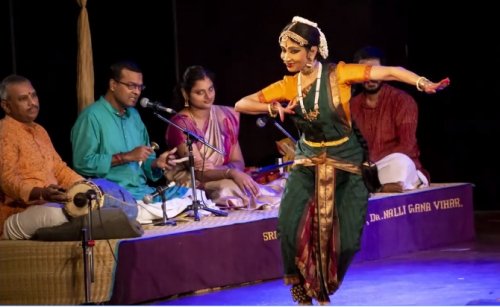 Alarmel Valli 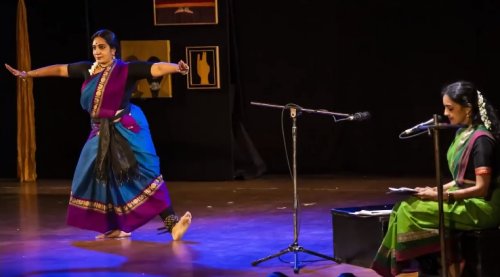 Uma Nambudripad & Lakshmi Parthasarathy Athreya Another unusual session was provided by Uma Nambudripad Sathyanarayanan and Lakshmi Parthasarathy Athreya in Shrama Vidhi dealing with Adavu codification of King Thulaja's (1729-1735) Sangeeta Saramruta. Dealing with a text very few people have cared to interpret in detail, and trying to reconstruct adavus by ploughing through the Sanskrit verses must have entailed a lot of effort. While most of the adavus in present day Bharatanatyam vocabulary can be traced in this work, a few like Sarukkal find no representation. Whether this work over six months, has yielded anything inspiring which can add to the Adavu repertoire of today, is difficult to say. "Only now we are seeing some possibilities, all this time it was recreating the adavus by interpreting the verses. And the writer was after all not a dancer, but a King." That their interpretation of the Sanskrit verses could be largely influenced by their Bharatanayam as practitioners is not denied. Apart from any new inspiration, any work adding to our knowledge of how Bharatanatyam has evolved through time, is all to the good. And that a few dancers have the foundation and urge to try discerning old texts is heartening. 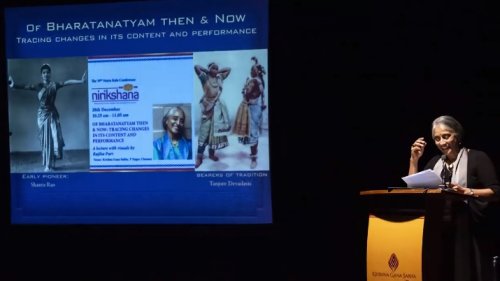 Rajika Puri 'Bharatanatyam Then and Now: Tracing changes in its content and performance' by Rajika Puri based in the United States, brought back old memories through some visuals of dancers like Shanta Rao, Balasaraswati, Kamala Laxman, Yamini Krishnamurthy and Sonal Mansingh - their technique, music, style and content of dance compared with what leading dancers of today are presenting. Dancers like Ram Gopal actually danced for a foreign audience and the context in which they performed was very different from the way one perceives a really proficient Bharatanatyam performance today, in a scenario where Bharatanatyam has proliferated in a way few foresaw. She mentioned how Shanta Rao's dance with its very manly power puzzled viewers because nobody else danced in the same manner. Yamini Krishnamurthy's recitals had Bharatanatyam followed by Kuchipudi or sometimes Odissi. Neither was Ram Gopal's araimandi what one demands of Bharatanatyam dancers today! In terms of themes and music too, the dance form with its margam recitals, not to speak of attempts at making the dance relate to concerns of the present day, speak of an entirely changed scenario. 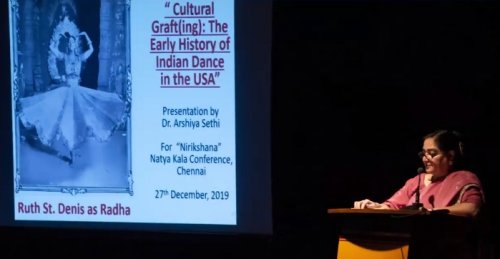 Dr. Arshiya Sethi 'Cultural Grafting: An Early History of Indian Dance in USA' by Dr. Arshiya Sethi (a Fulbright scholar as well as Fulbright Arts Fellow whose Doctorate on Sattriya concerned politics and dance) was just a segment from the larger research she has been engaged in, on this subject. Arshiya looks at this entire scenario of cultural grafting and asks a few pertinent questions on how respectful the process was with artists from a subordinate (India under the British) region having transactions with a part of the western world, with its spirit of entitlement. Were Indian artists in this climate acknowledged for their contribution? What of the appropriation, about which so much was said in the Indian context by the western world, which was never mentioned by anyone? From the Nautch dancers and jugglers, to the mysterious Asian Pavilion World Fair in Mississippi Coney Island Amusement Park (1904) to Ruth St. Denis with the imagined India in her dance with items like Incense, Cobra, Yogi, Radha and so on, to dancers like La Meri, Arshiya's examples showed the 'reverse racism' which was on. Ted Shawn presented his famous Nataraja Dance, seeking the Lord's help which he claimed enabled his being able to perform the dance, while the American God and Denishawn company denied citizenship to Caucasian dancers - one of such persons denied citizenship was Bhagat Singh Thind who had fought in the American war. Indian archive was not acknowledged even by Martha Graham and Charles Weidman. An African American allowed to dance with the Denishawn dancers, was not allowed to perform on stage. Racism with unacknowledged credits was the order of the day for Indian performers. Through some visuals and innumerable examples, Arshiya's was an informative and very interesting peek into dance history! Since Priya Srinivasan's book "Sweating Saris" nobody has attempted a detailed work on this subject, as Arshiya is attempting now. 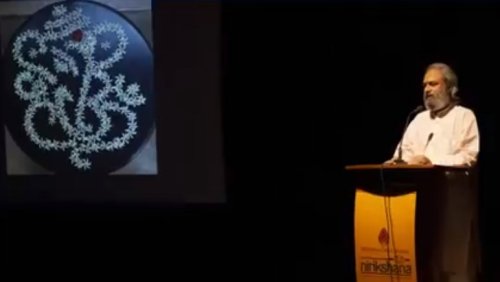 Ashish Mohan Khokar 'Saving Dance: Memories of a Nation' had Ashish Mohan Khokar speak about his legendary father Mohan Khokar's Dance Collection, which now in its entirety has been donated to the IGNCA Delhi and which now is in the process of being "sorted, organised, and gallerised before being digitised for all to benefit". Born in 1924 in undivided Punjab, Mohan Khokar, with the least sophisticated camera, began to take photographs and when the earthquake in 1935 on 31st May destroyed Quetta, what remained to tell the tragic story of death and destruction were his photographs. The collection is enormous - "4000 books, 108000 press clippings covering 100 years or more, 75000 photos from glass negatives to digital prints, approximately 1500 artefacts, 500 music tapes and recordings, 124 RPMs, 40 masks and 55 costumes." If recall of dance history requires the how, the why and the when with proof of events, Mohan Khokar did this for India's history of at least hundred years. Nirikshana: Natya Kala Conference marks its 39th year of celebration-2  Writing on the dance scene for the last forty years, Leela Venkataraman's incisive comments on performances of all dance forms, participation in dance discussions both in India and abroad, and as a regular contributor to Hindu Friday Review, journals like Sruti and Nartanam, makes her voice respected for its balanced critiquing. She is the author of several books like Indian Classical dance: Tradition in Transition, Classical Dance in India and Indian Classical dance: The Renaissance and Beyond. Post your comments Please provide your name and email id when you use the Anonymous profile in the blog to post a comment. All appropriate comments posted with name and email id in the blog will also be featured in the site. |